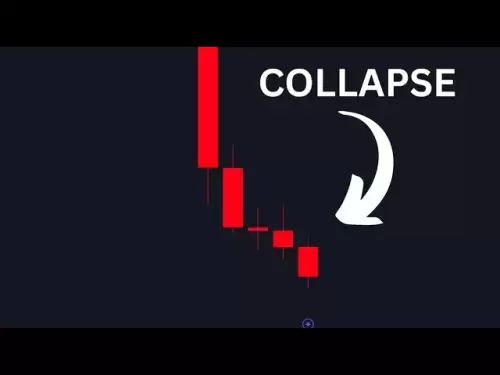-
 Bitcoin
Bitcoin $113900
-1.39% -
 Ethereum
Ethereum $3517
-4.15% -
 XRP
XRP $3.009
1.59% -
 Tether USDt
Tether USDt $0.9997
-0.04% -
 BNB
BNB $766.8
-1.41% -
 Solana
Solana $164.6
-2.38% -
 USDC
USDC $0.9998
-0.02% -
 TRON
TRON $0.3277
0.65% -
 Dogecoin
Dogecoin $0.2023
-1.67% -
 Cardano
Cardano $0.7246
0.05% -
 Hyperliquid
Hyperliquid $38.27
-4.77% -
 Sui
Sui $3.528
-0.52% -
 Stellar
Stellar $0.3890
-0.73% -
 Chainlink
Chainlink $16.16
-2.69% -
 Bitcoin Cash
Bitcoin Cash $539.9
-4.38% -
 Hedera
Hedera $0.2425
-2.00% -
 Avalanche
Avalanche $21.71
-0.97% -
 Toncoin
Toncoin $3.662
5.73% -
 Ethena USDe
Ethena USDe $1.000
-0.02% -
 UNUS SED LEO
UNUS SED LEO $8.964
0.35% -
 Litecoin
Litecoin $107.7
2.33% -
 Shiba Inu
Shiba Inu $0.00001223
-0.40% -
 Polkadot
Polkadot $3.617
-0.97% -
 Uniswap
Uniswap $9.052
-2.49% -
 Monero
Monero $295.1
-3.79% -
 Dai
Dai $0.9999
0.00% -
 Bitget Token
Bitget Token $4.315
-1.85% -
 Pepe
Pepe $0.00001060
0.11% -
 Cronos
Cronos $0.1342
-2.72% -
 Aave
Aave $256.0
-0.87%
How is the funding fee of perpetual contract calculated?
When the funding rate is positive, traders holding long positions pay fees to those holding short positions to encourage shorting and bring the contract price closer to the spot price.
Oct 21, 2024 at 08:11 pm

Understanding Funding Fees in Perpetual Contracts
Perpetual contracts, also known as inverse futures, are a popular type of derivative in the cryptocurrency market. Unlike traditional futures contracts that have an expiry date, perpetual contracts remain open indefinitely. To align the prices of perpetual contracts with their underlying assets, funding fees are introduced as a mechanism to maintain price parity.
Perpetual Contract Funding Fees
Funding fees are paid or received by traders based on the difference between the perpetual contract price and the funding rate. The funding rate is typically calculated every 8 hours and adjusted to ensure that the contract price closely tracks the spot market.
Methodology for Calculating Funding Fees
Step 1: Determine Market Sentiment
The funding rate reflects the market's sentiment towards a particular asset. If there are more long positions (bets that the price will rise) than short positions (bets that the price will fall), the funding rate will be positive. Conversely, if there are more short positions, the funding rate will be negative.
Step 2: Set Funding Threshold
A positive funding rate encourages longs to close their positions or shorts to open their positions. Conversely, a negative funding rate discourages shorts from opening positions or encourages longs to close their positions.
Step 3: Funding Rate Calculation
The funding rate is typically set on an 8-hourly basis and calculated using the following formula:
Funding Rate = (Longs Interest Rate - Shorts Interest Rate) / 8Longs Interest Rate: This rate is calculated based on the prevailing bid price and represents the borrowing cost for longs.
Shorts Interest Rate: This rate is calculated based on the prevailing ask price and represents the borrowing cost for shorts.
Step 4: Apply Funding Fees
The funding fee is applied to each trader's account based on their position size and the funding rate. Traders who hold long positions pay funding fees to traders who hold short positions. Conversely, traders who hold short positions receive funding fees from traders who hold long positions.
Example of Funding Fee Calculation
Let's say the perpetual contract price for Bitcoin (BTC) is $20,000, while the spot price is $19,980. This indicates that the perpetual contract price is slightly higher than the spot price.
Assuming the longs interest rate is 0.01% (0.0001) and the shorts interest rate is 0.002% (0.00002), the funding rate would be calculated as:
Funding Rate = (0.0001 - 0.00002) / 8 = 0.0000125This positive funding rate encourages traders to open short positions and close long positions, potentially bringing the perpetual contract price closer to the spot price.
Disclaimer:info@kdj.com
The information provided is not trading advice. kdj.com does not assume any responsibility for any investments made based on the information provided in this article. Cryptocurrencies are highly volatile and it is highly recommended that you invest with caution after thorough research!
If you believe that the content used on this website infringes your copyright, please contact us immediately (info@kdj.com) and we will delete it promptly.
- Worldcoin, Identity, WLD Price: Decoding the NYC Crypto Buzz
- 2025-08-02 21:10:12
- Shiba Inu: Utility and Community Strength Drive Crypto's Evolution
- 2025-08-02 21:50:12
- Crypto Donations, Trump PAC, and Bitcoin: A New York Minute on Political Coin
- 2025-08-02 20:30:12
- Crypto Market Under Pressure: Bearish Momentum and Rising Volatility Take Hold
- 2025-08-02 20:30:12
- Crypto Market Carnage: Liquidations Soar as Ethereum and Bitcoin Take a Beating
- 2025-08-02 21:55:12
- DeFi Token Summer Gains: Is Mutuum Finance the Real Deal?
- 2025-08-02 18:30:12
Related knowledge

Why is my Bitstamp futures position being liquidated?
Jul 23,2025 at 11:08am
Understanding Futures Liquidation on BitstampFutures trading on Bitstamp involves borrowing funds to open leveraged positions, which amplifies both po...

How to report Bitstamp futures for taxes?
Jul 30,2025 at 08:35am
Understanding Bitstamp Futures and Taxable EventsWhen trading Bitstamp futures, it’s essential to recognize that these financial instruments are treat...

Does Bitstamp offer inverse contracts?
Jul 23,2025 at 01:28pm
Understanding Inverse Contracts in Cryptocurrency TradingIn the realm of cryptocurrency derivatives, inverse contracts are a specific type of futures ...

What is the difference between futures and perpetuals on Bitstamp?
Jul 27,2025 at 05:08am
Understanding Futures Contracts on BitstampFutures contracts on Bitstamp are financial derivatives that allow traders to speculate on the future price...

How to find your Bitstamp futures trade history?
Jul 23,2025 at 08:07am
Understanding Bitstamp and Futures Trading AvailabilityAs of the current state of Bitstamp’s service offerings, it is critical to clarify that Bitstam...

Can I use a trailing stop on Bitstamp futures?
Jul 23,2025 at 01:42pm
Understanding Trailing Stops in Cryptocurrency TradingA trailing stop is a dynamic type of stop-loss order that adjusts automatically as the price of ...

Why is my Bitstamp futures position being liquidated?
Jul 23,2025 at 11:08am
Understanding Futures Liquidation on BitstampFutures trading on Bitstamp involves borrowing funds to open leveraged positions, which amplifies both po...

How to report Bitstamp futures for taxes?
Jul 30,2025 at 08:35am
Understanding Bitstamp Futures and Taxable EventsWhen trading Bitstamp futures, it’s essential to recognize that these financial instruments are treat...

Does Bitstamp offer inverse contracts?
Jul 23,2025 at 01:28pm
Understanding Inverse Contracts in Cryptocurrency TradingIn the realm of cryptocurrency derivatives, inverse contracts are a specific type of futures ...

What is the difference between futures and perpetuals on Bitstamp?
Jul 27,2025 at 05:08am
Understanding Futures Contracts on BitstampFutures contracts on Bitstamp are financial derivatives that allow traders to speculate on the future price...

How to find your Bitstamp futures trade history?
Jul 23,2025 at 08:07am
Understanding Bitstamp and Futures Trading AvailabilityAs of the current state of Bitstamp’s service offerings, it is critical to clarify that Bitstam...

Can I use a trailing stop on Bitstamp futures?
Jul 23,2025 at 01:42pm
Understanding Trailing Stops in Cryptocurrency TradingA trailing stop is a dynamic type of stop-loss order that adjusts automatically as the price of ...
See all articles

























































































